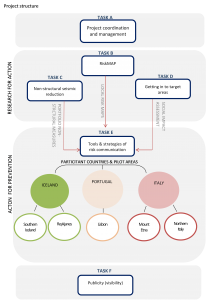Estrutura
Estrutura
O programa de investigação será dividido em seis tarefas, cada uma contribuindo para um ou mais sub-metas.
KnowRISK compreende essencialmente dois principais blocos de actividades, nomeadamente Investigação de Ação e Ação para a Prevenção. Três linhas de actividade inter-relacionados, incluídas no bloco Investigação de Ação , irão produzir a entrada de conhecimento para ser entregue às comunidades nos 3 países participantes e áreas piloto (Recurso de bloco de Prevenção).
A primeira linha de atividade é dedicada à definição de cenários sísmicos críticas por danos não estruturais em cada país participante (Task B) e será ladeado de um lado por uma linha que vai produzir uma Carteira de medidas não-estruturais (Task C ), e, por outro lado, por uma linha que vai investigar o nível de conhecimento em comunidades específicas (Tarefa D) de modo a que a comunicação de risco terá em conta o contexto social e cultural. Uma compilação sistemática de acções de protecção sísmica não estruturais em Task C vai levar ao desenvolvimento de uma carteira de boas práticas para reduzir as vulnerabilidades não-estruturais mais comuns. Este objectivo será alcançado através de uma estratégia de "cross-conhecimento" entre a pesquisa anterior, evidência de danos causados por elementos não-estruturais em terremotos anteriores e com a entrada de experiência na área de prevenção de danos não estruturais. Avaliação do nível de consciência sobre a importância de procedimentos não-estruturais por proprietários e profissionais de construção (Task D) será construído através da aplicação de técnicas de inquérito / questionário, ou seja, utilizando novas ferramentas de comunicação web. É de particular importância a ter áreas de investigação com uma história diferente de experiência de desastres para implementar uma abordagem de redução do risco de desastres de base comunitária. Através desta diversidade, pretende-se criar oportunidades de aprendizagem mútua entre os profissionais e os usuários finais.
Em Ação para estratégias de comunicação de risco bloco Prevenção e abordagens participativas serão usadas para aumentar a consciência para mitigação de risco não-estruturais e melhorar a capacidade adaptativa dos cidadãos para o perigo (Task E). Esta comunicação, por meio de ações simples e pouco dispendiosos, é fortemente subestimado pela maioria das pessoas em todo o mundo.
KnowRISK será implementado em grupos da sociedade que têm exposição específica para a vulnerabilidade não estrutural, ou seja, as escolas, as famílias e público em geral como um todo e a eficácia das estratégias será estimada em ambos os de curto e longo prazos. Divulgação de boas práticas e realizações científicas no âmbito do projecto (Tarefa F) será essencialmente voltado para esses grupos.

